

























North American F-86D Sabre Dog (NA-173)
Single-engine single-seat swept-wing tri-gear all-weather jet fighter/interceptor, U.S.A.
Archive Photos

Archive Photos
North American F-86D-35-NA Sabre Dog (NA-173, AF 51-6261, c/n 173-405, painted as AF 52-10115) displayed 12/2007 on a pylon at Chandler, Arizona (Photos by Ron Strong) 2

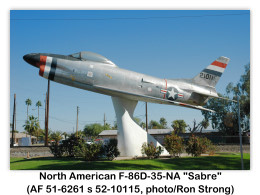
North American F-86D-35-NA Sabre Dog (NA-173, AF 51-6261, c/n 173-405, painted as AF 52-10115) displayed 3/15/2011 on a pylon at Chandler, Arizona (Photo by Lt. Col. Dr. Marc Matthews, USAF retired) 3


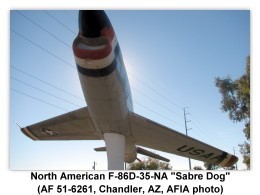





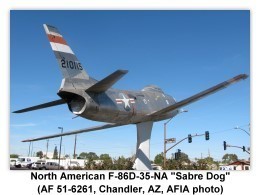


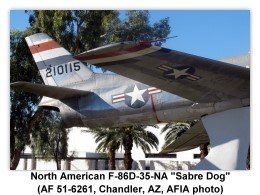
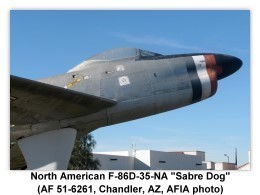
North American F-86D Overview
North American F-86D Sabre Dog
- Role: Fighter interceptor
- Manufacturer: North American Aviation
- First flight: 22 December 1949
- Primary users: United States Air Force; Italian Air Force; SFR Yugoslav Air Force; Venezuelan Air Force
- Number built F-86D: 2,504
- Number built F-86D/K/L: 2,847
- Unit cost: USD $343,839 (F-86D)
- Developed from: North American F-86 Sabre
The North American F-86D Sabre (sometimes called the Sabre Dog or Dog Sabre" was a transonic jet all-weather interceptor of the United States Air Force and others. Based on North American’s F-86 Sabre day fighter, the F-86D had only 25 percent commonality with other Sabre variants, with a larger fuselage, larger afterburner engine, and a distinctive nose radome.
Design and Development
The North American YF-95 was a development of the F-86 Sabre, the first aircraft designed around the new 2.75-inch (70 mm) Mighty Mouse Folding-Fin Aerial Rocket (FFAR). Begun in March 1949, the unarmed prototype, AF 50-577, first flew on 22 December 1949, piloted by North American test pilot George Welch and was the first U.S. Air Force night fighter design with only a single crewman and a single engine, a J47-GE-17 with afterburner rated at 5,425 lbf (24.1 kN) static thrust. Gun armament was eliminated in favor of a retractable under-fuselage tray carrying 24 unguided Mk.4 rockets, then considered a more effective weapon against enemy bombers than a barrage of cannon fire. A second prototype, AF 50-578, was also built, but the YF-95 nomenclature was short-lived as the design was subsequently redesignated North American YF-86D.
Rocket Tray

The fuselage was wider and the airframe length increased to 40 ft 4 in (12.29 m), with a clamshell canopy, enlarged tail surfaces and AN/APG-36 all-weather radar fitted in a radome in the nose, above the intake. Later models of the F-86D received an uprated J-47-GE-33 engine rated at 5,550 lbf (24.7 kN) (from the F-86D-45 production blocks onward). A total of 2,504 D-models were built.
Operational History
On 18 November 1952, F-86D, AF 51-2945, set a speed record of 698.505 mph (1,124.1 km/h). Captain J. Slade Nash flew over a three km (1.8 mi.) course at the Salton Sea in southern CA at a height of only 125 ft (38 m). Another F-86D broke this world record on 16 July 1953, when Lieutenant Colonel William F. Barns, flying F-86D AF 51-6145, in the same path of the previous flight, achieved 715.697 mph (1,151.8 km/h).
Variants
- North American YF-95A (NA-164): Prototype all-weather interceptor; two built; designation changed to YF-86D.
- North American YF-86D (NA-164): Originally designated YF-95A.
- North American F-86D: (NA-165/173/177/190/201) Production interceptor originally designated F-95A, 2,504 built.
- North American F-86G (NA-177): Provisional designation for F-86D variant with uprated engine and equipment changes, 406 built as F-86Ds.
- North American YF-86K (NA-205): Basic version of F-86D intended for export with rocket tray replaced by four 20mm cannon and simplified fire control system, two conversions.
- North American/Fiat F-86K (NA-201/201/213/221/232/242): NATO version of F-86D; MG-4 fire control system; four 20mm M24A1 cannon with 132 rpg; APG-37 radar. 120 were built by North American, 221 were assembled by Fiat.
- North American F-86L: Upgrade conversion of F-86D with new electronics, extended wingtips and wing leading edges, revised cockpit layout, and uprated engine; 981 converted.
Operators
- Denmark: Royal Danish Air Force. Received 59 ex-USAF F-86Ds 1958-1960; assigned to 723, 726 and 728 Squadrons.
- France: French Air Force. Fiat built 62 F-86Ks for France (1956-1957), assigned to EC 1/13 Artois, EC 2/13 Alpes, and EC 3/13 Squadrons. Serials were 55-4814/4844, 55-4846/4865, 55-4872/4874, 55-4876/4879.
- West Germany: German Air Force. Acquired 88 U.S. F-86Ks 22 July 1957-23 June 1958. The Ks were assigned to Jagdgeschwader 75/renamed 74.
- Greece: Greek Air Force. Acquired 35 F-86Ds from U.S. Were received in 1961 and retired in 1967 but kept as back up until 1969. the North American F-86D was the first all weather fighter in Greek Air Force. North American F-86Ds were assigned to 337 & 343 Squadrons. Until 1964 were in natural metal. After retirement were in NATO camouflage.
- Honduras: Honduran Air Force. Acquired Six Venezuelan F-86Ks in 1970.
- Italy: Italian Air Force. Fiat produced 121 F-86Ks for Italy, 1955-1958. Also, 120 U.S. F-86Ks were acquired. F-86s were assigned to the AMI air groups: 6 Gruppo COT/1 Stormo, 17 Gruppo/1 Stormo, 23 Gruppo/1 Stormo, 21 Gruppo/51 Aerobrigata, 22 Gruppo/51 Aerobrigata and 12 Gruppo/4 Aerobrigata.
- Japan: Japanese Air Self-Defense Force. Acquired 122 US F-86Ds, 1958-1961; assigned to four all-weather interceptor Hikotai, and Air Proving Ground at Gifu.
- Netherlands: Royal Netherlands Air Force (Koninklijke Luchtmacht) (KLu). Acquired 57 U.S.-built and six Fiat-built F-86K Sabres, 1955-1956; and assigned to three squadrons, No. 700, 701 and 702. Operated until 1964.
- Norway: Royal Norwegian Air Force. Acquired 60 U.S.-built F-86K Sabres, 1955-1956, and four Italian-assembled Fiat F-86K-models.
- Philippines: Philippine Air Force. Acquired 20 F-86Ds, assigned to 8th Fighter Interceptor Squadron "Vampires" beginning 1960; part of the U.S. military assistance package.
- South Korea: Republic of Korea Air Force. Acquired 40 F-86Ds, beginning 20 June 1955.
- Republic of China (Taiwan): Republic of China Air Force.
- Turkey: Turkish Air Force. Acquired 50 US-built F-86Ds, and 40 F-86Ks.
- Thailand: Royal Thai Air Force. Acquired 20 F-86Ls.
- United States: United States Air Force.
- Venezuela: Venezuelan Air Force. Acquired 32 US-built F-86Fs, October 1955-December 1960; 1965 acquired 79 Fiat-built F-86Ks from West Germany.
- Yugoslavia: SFR Yugoslav Air Force. Acquired 130 U.S.-made F-86Ds and operated them between 1961 and 1974.
North American F-86D-40-NA Specifications 4,5,6,7
Type:
- Single-seat jet-propelled fighter.
Wings:
- Low-wing cantilever monoplane with 35° sweep-back.
- Thin laminar-flow wing section.
- All-metal structure of sandwich type construction in which the structural material is laminated between the inner and outer tapered skins.
- No ribs in inboard halves of wing panels and skin is milled from 0¼-in. material at roots.
- Auto slots on leading-edge.
- Slotted flaps.
- Hydraulic aileron boost.
- Gross wing area 274 ft² (25.4 m²)
Fuselage:
- Oval section all-metal structure with flush-riveted stressed skin.
- Air intake pre-positioned under nose, which closed radar scanner.5
Tail Unit:
- Cantilever monoplane type.
- All-metal structure.
- All surfaces have 35° sweep-back.
- Dihedral tailplane.
- Hydraulic elevator boost.
Landing Gear:
- Retractable tricycle type with steerable nose-wheel.
- Hydraulic retraction.
- Cleveland 8657 air-oil shock struts.
- Bendix 26-in. (66 cm) magnesium wheels and Bendix rotor-disc hydraulic brakes on main wheels.
- Track 8 ft. 3 in. (2.5 m.).
Powerplant:
- One General Electric J-47-GE-17 axial-flow gas turbine (5,425-lb-thrust); 7,500-lb-thrust with afterburner.*
- External long-range drop-tanks may be carried under wings outboard of landing-gear.
Accommodation:
- Pressurized pilot’s cockpit with clamshell5 canopy.
canopy.
- Pilot ejection seat.
Armament and Equipment:
- Six 0.50-in. (12.7 mm) machine-guns in nose.
- Provision for 16 5-in. (127 mm) rockets under wings.
- Latest radio, radar and navigation equipment.
Dimensions:
- Span: 37 ft. 1½ in. (11.3 m).
- Length: 40 ft. 3 in.
- Height: 15 ft.
Weights:
- Empty weight: 13,518 lb.
- gross weight: 19,975 lb.
Performance: 7
- Cruising speed: 533 mph
- Maximum speed: 679 mph
- Climb rate: 7,470 ft/min
- Ceiling: 48,000 ft
- Combat radius: 330 miles
- Ferry range: 1,052 miles
References
- 3-View Drawing: John Shupek
- Photos: Ron Strong
- Photos: Lt. Col. Dr. Marc Matthews, USAF retired, a.k.a. AFIA
- Wikipedi: North American F-86 Sabre
- Bridgman, Leonard. Jane’s All The World’s Aircraft 1950/51, Sampson Low, Marston & Company, Ltd., London, 1951, pp 262c-264c
- Bridgman, Leonard. Jane’s All The World’s Aircraft 1950/51, Sampson Low, Marston & Company, Ltd., London, 1951, pp 271c
- Avery, Norm, North American Aircraft 1934-1998, Volume 1, Santa Ana, CA: Narkiewicz//Thompson, 1998, ISBN 0-913322-05-9, pp 148



































































